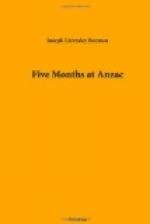We annexed all the pans and boilers and made good use of them for our own Ambulance. Then, proceeding further up the gully, we found it almost impassable by reason of dead Ghurkas and mules; a gun on a ridge had the range of this place to a nicety, and the ammunition train was held up for a time. I never saw such a mess of entangled mules; they were kicking and squealing, many of them were wounded, and through it all the Indian drivers were endeavouring to restore some kind of order. One had to keep close under the banks to escape the shells. Not far from here was the emplacement of our old friend “Windy Annie,” but alas! Annie was constant to Abdul, and they had taken her with them. It was a great pity we did not get the gun. No wonder our guns never found the place. The ground had been dug out to some depth and then roofed over with great logs and covered with earth and sandbags; the ammunition—plenty of it—was in deep pits on either side; artillery quarters were in close proximity, and the tracks of the gun were clearly seen.
The shelling was far too heavy to let us pitch a dressing station anywhere here, so we retired to the beach to find a place more sheltered under the hills; the bearers meanwhile followed the troops. Soon scores of casualties began to arrive, and we selected a position in a dry creek about six yards wide, with high banks on either side. The operating tent was used as a protection from the sun and stretched from bank to bank, the centre being upheld by rifles lashed together; the panniers were used to form the operating table, and our drugs were placed round the banks. We were, however, much handicapped by not having any transport, as our donkeys had been requisitioned by the Army Service Corps. Everything had to be carried from a distance, and water was exceedingly scarce. All day we were treating cases and operating until late at night. Major Meikle and I divided the night, and we were kept going. From one until four in the morning I slept in a hole in a trench like a tomb.
At daylight we could see our men righting their way through the scrub over Sari Bair, the warships firing just ahead of them to clear the scrub of the Turkish Infantry. The foremost men carried flags, which denoted the farthest point reached and the extent of the two flanks, as a direction to the ship. With the glasses one could see that the bayonet was being used pretty freely; the Turks were making a great stand, and we were losing a lot of men. They could be seen falling everywhere.




